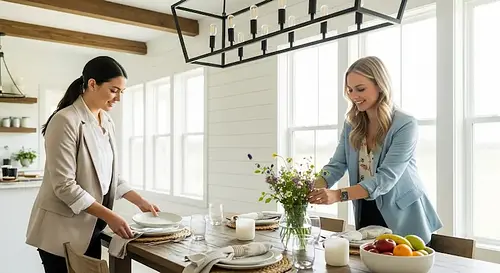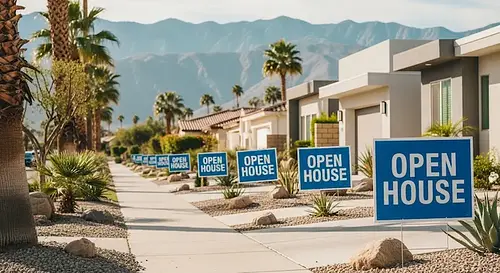Maximize Your Open House Success: The Ultimate Guide To Using A Sign In Sheet Effectively
Want to turn open house visitors into real leads? Discover how a simple sign-in sheet can unlock powerful connections, guide your follow-ups, and boost your sales strategy. In this ultimate guide, you'll learn to transform a basic form into one of your most valuable real estate tools.

Written by Seth Cox
May 05, 2025 / Open house marketing
The Importance of a Sign-In Sheet at Open Houses
Moreover, a well-utilized sign-in sheet provides insights into the effectiveness of your open house marketing efforts. By analyzing who attended the open house, their demographics, and their buying intentions, you can gauge which advertising channels are most successful. This information helps fine-tune future campaigns, ensuring you attract the right audience. Essentially, the sign-in sheet serves as a feedback loop, continually enhancing your marketing precision.
In addition, having a comprehensive sign-in sheet can be a powerful tool for accountability and security. Knowing who entered the property and at what time can be crucial in the event of any issues or concerns. It also gives potential buyers a sense of professionalism and organization, contributing positively to their overall impression of the property and the agent. A meticulously kept sign-in sheet exemplifies your dedication to detail, which is a reassuring trait for any potential buyer.
Key Elements of an Effective Sign-In Sheet
To delve deeper, consider including questions that gauge the visitor's buying timeline and budget range. These questions, while optional, can provide critical insights into the urgency and financial capacity of potential buyers. Understanding whether a visitor is just browsing or ready to make a purchase can significantly influence how you prioritize follow-ups and allocate your resources.
Lastly, adding a section for notes or comments can be immensely beneficial. This space allows visitors to share their thoughts about the property, which can give you immediate feedback on what aspects of the house resonate with buyers and what might need improvement. Collecting this qualitative data can be as valuable as the quantitative, providing a comprehensive picture of buyer sentiment.
How to Design an Engaging Sign-In Sheet
Designing an engaging sign-in sheet involves a blend of aesthetics and functionality. Start with a clean, uncluttered layout that is easy to read and fill out. Use a professional font and ensure there is ample space between fields to avoid a cramped look. An attractive, streamlined design can make the sign-in process more inviting and less of a chore.
Incorporate your branding subtly within the sign-in sheet. This could be your logo at the top or using your brand colors throughout the sheet. Consistent branding reinforces your professional image and makes the sheet look more official. Additionally, providing clear instructions at the top can help guide visitors through the process, ensuring they fill out all necessary fields correctly.
Consider adding a touch of personalization, such as a welcoming message or a brief introduction about the property. This small gesture can make visitors feel more comfortable and appreciated. Remember, the goal is to make the sign-in process as pleasant and engaging as possible, setting a positive tone for their overall open house experience.
Digital vs. Paper Sign-In Sheets: Pros and Cons
Digital open house sign-in apps, on the other hand, offers numerous advantages. They provide a more streamlined and professional appearance and can often be integrated with CRM systems for immediate data processing. Digital sheets reduce the chances of errors and ensure all fields are filled out completely. However, they require a reliable internet connection and familiarity with the technology, which might be a barrier for some visitors.
Each option has its merits, and the choice largely depends on your target audience and personal preference. Some agents even opt for a hybrid approach, offering both paper and digital options to accommodate all visitors. Ultimately, the goal is to ensure the process is as seamless and efficient as possible, regardless of the medium.
Best Practices for Collecting and Managing Data
Regularly update and clean your database to remove duplicates, correct errors, and ensure all data is current. This process, known as data hygiene, is crucial for maintaining the integrity of your information. Accurate data allows for more effective follow-ups and better-targeted marketing efforts. Make it a routine practice to review and update your database after each open house.
Segmenting your data based on criteria such as buying timeline, budget, and interest level can significantly enhance your follow-up strategy. By categorizing leads, you can tailor your communication to address their specific needs and preferences. This personalized approach increases the likelihood of conversion, as potential buyers feel understood and valued.
Strategies to Encourage Sign-In Participation
Offering an incentive can be a powerful motivator. Consider running a small raffle or offering a gift card in exchange for completing the sign-in sheet. This not only encourages participation but also creates a sense of excitement and engagement. Make sure the incentive is appealing enough to entice visitors but not so extravagant that it appears desperate.
Transparency is key. Clearly explain how the information will be used and reassure visitors that their data will be kept confidential. People are more likely to provide their contact details if they understand the purpose and feel their privacy is respected. A brief explanation about follow-up procedures and the benefits of staying in touch can go a long way in gaining trust and cooperation.
Utilizing Sign-In Data for Post-Open House Follow-Up
Segment your follow-up strategy based on the data collected. For instance, prioritize leads who indicated an immediate buying timeline. Tailor your communication to address their specific needs and concerns, providing additional information or scheduling private showings. For visitors who are not ready to buy yet, consider sending regular updates about the property market or invitations to future open houses to keep them engaged.
Utilize your CRM system to automate and track follow-up communications. This ensures no lead falls through the cracks and allows you to maintain a consistent follow-up schedule. Personalize your messages as much as possible, using the information gathered from the sign-in sheet to reference specific preferences or questions the visitor had. This level of attention can significantly enhance your chances of converting leads into buyers.
Common Mistakes to Avoid with Sign-In Sheets
Another error is not reviewing and organizing the collected data promptly. Delays in processing this information can lead to missed opportunities for timely follow-ups. Make it a standard practice to enter and review the data immediately after the open house, ensuring you can act on it while the visitor's interest is still fresh.
Overloading the sign-in sheet with too many fields or complex questions can deter visitors from filling it out completely. Keep the sheet concise and focus on collecting only the most critical information. A streamlined, user-friendly sign-in sheet is more likely to be completed accurately and fully.
Innovative Ideas to Enhance Your Open House Experience
Hosting themed open houses can also be a hit. Whether it’s a wine and cheese night or a neighborhood block party, creating a unique event can attract more visitors and make the open house more enjoyable. These events can also provide a natural opportunity for socializing, making it easier to collect sign-in information and engage with potential buyers.
Leveraging feedback collected from the sign-in sheet to improve future open houses is another innovative approach. Use visitor comments and suggestions to refine your presentation and address any concerns. Continual improvement based on real-time feedback ensures your open houses become increasingly effective and engaging.
Conclusion: Elevating Your Open House with a Sign-In Sheet
Avoiding common pitfalls and continuously enhancing the open house experience will set you apart in a competitive market. By mastering the use of sign-in sheets, you not only gather valuable information but also build lasting connections with potential buyers. This ultimate guide provides the foundation for turning each visitor into a potential buyer, making your open houses not just successful but unforgettable.
Embrace the potential of the sign-in sheet and watch as your open house efforts translate into tangible results. With attention to detail, strategic planning, and a commitment to excellence, you can elevate your open house experience and drive meaningful sales. Let this guide be your roadmap to achieving open house success through the effective use of sign-in sheets.






